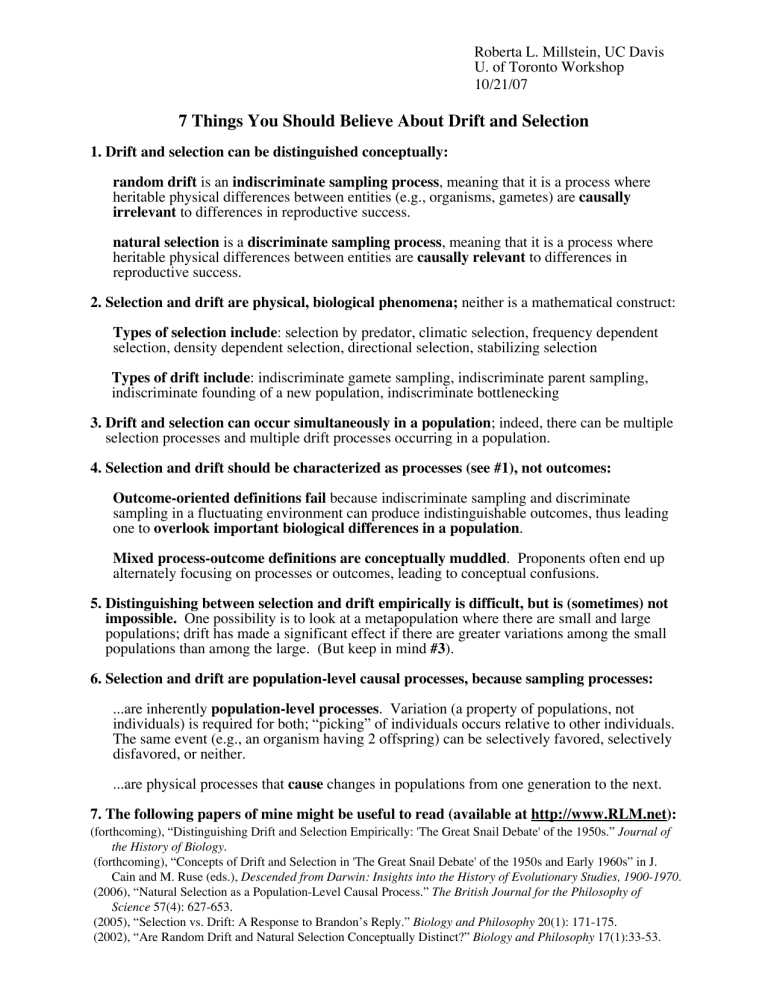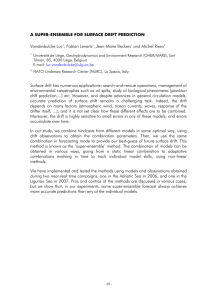
Roberta L. Millstein, UC Davis U. of Toronto Workshop 10/21/07 7 Things You Should Believe About Drift and Selection 1. Drift and selection can be distinguished conceptually: random drift is an indiscriminate sampling process, meaning that it is a process where heritable physical differences between entities (e.g., organisms, gametes) are causally irrelevant to differences in reproductive success. natural selection is a discriminate sampling process, meaning that it is a process where heritable physical differences between entities are causally relevant to differences in reproductive success. 2. Selection and drift are physical, biological phenomena; neither is a mathematical construct: Types of selection include: selection by predator, climatic selection, frequency dependent selection, density dependent selection, directional selection, stabilizing selection Types of drift include: indiscriminate gamete sampling, indiscriminate parent sampling, indiscriminate founding of a new population, indiscriminate bottlenecking 3. Drift and selection can occur simultaneously in a population; indeed, there can be multiple selection processes and multiple drift processes occurring in a population. 4. Selection and drift should be characterized as processes (see #1), not outcomes: Outcome-oriented definitions fail because indiscriminate sampling and discriminate sampling in a fluctuating environment can produce indistinguishable outcomes, thus leading one to overlook important biological differences in a population. Mixed process-outcome definitions are conceptually muddled. Proponents often end up alternately focusing on processes or outcomes, leading to conceptual confusions. 5. Distinguishing between selection and drift empirically is difficult, but is (sometimes) not impossible. One possibility is to look at a metapopulation where there are small and large populations; drift has made a significant effect if there are greater variations among the small populations than among the large. (But keep in mind #3). 6. Selection and drift are population-level causal processes, because sampling processes: ...are inherently population-level processes. Variation (a property of populations, not individuals) is required for both; “picking” of individuals occurs relative to other individuals. The same event (e.g., an organism having 2 offspring) can be selectively favored, selectively disfavored, or neither. ...are physical processes that cause changes in populations from one generation to the next. 7. The following papers of mine might be useful to read (available at http://www.RLM.net): (forthcoming), “Distinguishing Drift and Selection Empirically: 'The Great Snail Debate' of the 1950s.” Journal of the History of Biology. (forthcoming), “Concepts of Drift and Selection in 'The Great Snail Debate' of the 1950s and Early 1960s” in J. Cain and M. Ruse (eds.), Descended from Darwin: Insights into the History of Evolutionary Studies, 1900-1970. (2006), “Natural Selection as a Population-Level Causal Process.” The British Journal for the Philosophy of Science 57(4): 627-653. (2005), “Selection vs. Drift: A Response to Brandon’s Reply.” Biology and Philosophy 20(1): 171-175. (2002), “Are Random Drift and Natural Selection Conceptually Distinct?” Biology and Philosophy 17(1):33-53.



